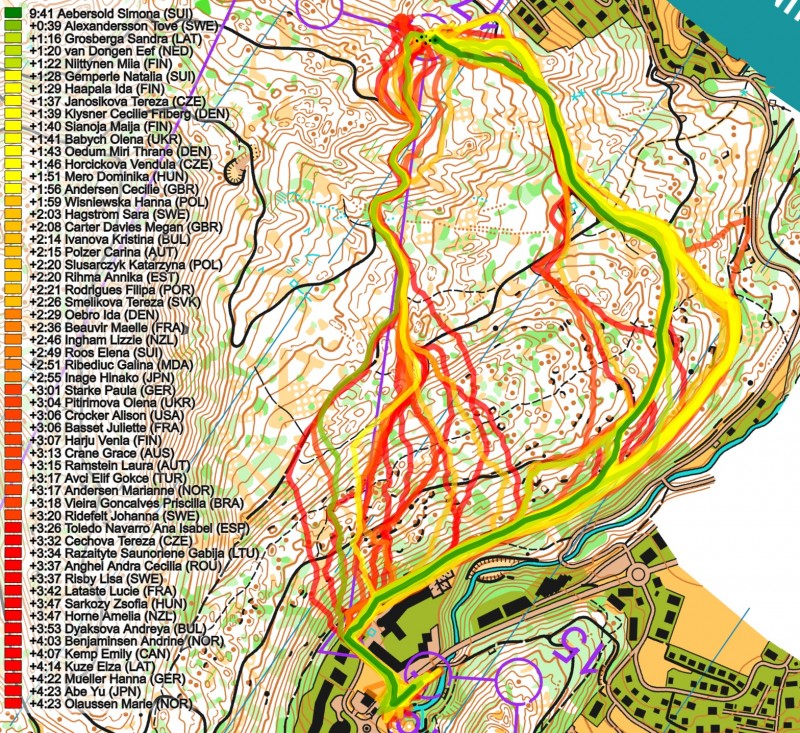
The WOC 2023 Long courses offered an excellent mix of different terrain types and challenges. Here we take a look at the key legs that posed the toughest challenges for the runners, and how these legs decided the exciting battles for the medals.
The courses were built up of three different parts. The first part was set in alpine open and semi-open terrain, inviting the runners to high speed with a mix of tricky and easier controls. This part also featured the longest leg, which was more about micro route choices than about chosing between distinct alternatives.The second part was characterized by steep downhills, which was challenging both technically and physically. Although there were not that many big mistakes in this part, this is were there were largest time differences between the best runners and the rest of the field.
The third and final part was set down on the plateau, having a hilly characteristic with rounder forms and many contour details, making it possible for the route planners to make some very interesting route choice legs. One of the most decisive legs in the third part was the 17th leg in the women’s class shown above (very similar also the 29th leg in the men’s class). We will get back to these legs towards the end of this analysis.
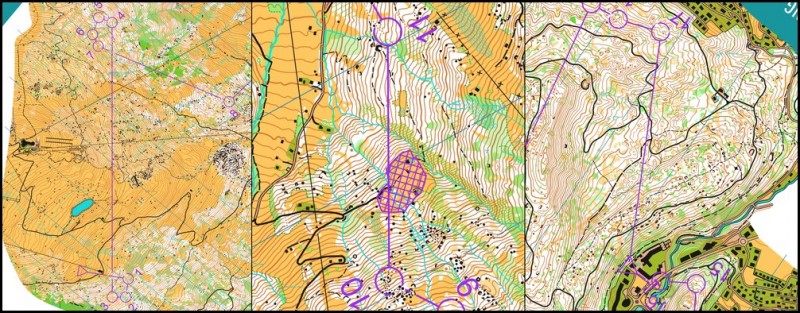
Illustration: The three different parts of the courses: Open, steep downhill and hilly.
First part 1: Alpine open and semi-open terrain – women leg #1
A good example of a tricky control in this part of the terrain were many runners lost time is the first control in the women’s course. The leg goes straight down a quite steep hill in semi-open terrain with the mapped features not being very distinct in the terrain.
Several top runners lost 1:30 or more already here, including bronze medalist Andrine Benjaminsen (Norway) losing 1:36, and the two Swedes Johanna Ridefelt and Lisa Risby losing 2 and 3 minutes,
This is a control where it is difficult to find the lower-risk approach which you would want at the start of such a 80-100 minute adventure. The key here is to know exactly where you are when leaving the road, have a clear plan regarding which features you plan to use (and which you think are distinct enough to find) on the way into the control, be accurate with your compass direction and trust yourself so that you don’t stop or turn too early.
First part 2: Alpine open and semi-open terrain – women leg #4
The courses only features one really long leg in the first part of the course. For the women this was the 4th leg. This leg is more about micro route choices and execution than about chosing between several distinvt options.
To avoid losing time on such legs, you should try to plan a route where you can keep the speed high while using relatively large and well visible features for your navigation. You really have to study the leg in detail to understand where the runnability is good and bad – and how to approach the control in a good way. Generally the runnability is low in very steep parts of the hillside (although you can get lucky and find terraces/tracks made by animals in the steep hillsides), light yellow areas where the low vegatation may force you to reduce the speed a lot, and green and stony areas. Also, it is a good idea to plan an approach which reduces the navigational challenges and be accurate in your execution while not becoming passive. A few variants which mostly avoid these low speed areas are shown below, named variant A to D. Here D requires more climb but is shorter, while A-C offer some different micro route choices.
Looking at all routes with the routes colored by split time – green being fast and red slow – we see that it is possible to run quite fast both to the left and the right – and also to lose significant time both to the left and right.
Looking at the Top 6 women for this leg, we see that there is only 4 seconds between Aebersolds route to the right and Roos’ route to the left, but Gemperle to the left and Hagström to the right each lose two minutes on poorer micro route choices. Alexandersson’s two minute time loss here is another story – this is due to not being accurate in the execution when approaching the control, making a quite big mistake.
The men had a very similar but longer leg, with very similar challenges.
Second part: Steep downhill – women leg #8
The second part of the terrain features steep downhill running, mostly in forested terrain of varying density, with some smaller open and semi-open areas interspered. Keys for good performance seems to be avoiding the green and stony areas, accompanied by accurate direction running to avoid getting into these green or stony areas. In addition it is important to not become passive, keeping the speed up. Here is the women’s leg to control 8 as an example of such a leg.
Below the chosen routes are colored according to split time to show that there are two main routes (left and right) that avoid nearly all green areas that are fast, while you lose significant time if you get into the green. The safer option here is going to the left onto the open area – more runners do small mistakes into the control when running to the right.
Third part 1: Hilly terrain on plateau – women leg #17
The third part in the hilly terrain with some really nice route choice legs was the most decisive part of the courses. To make it extra hard for the runners, the course setters had introduced a map exchange just before the cruicial route choice leg to control 17 in the women’s course and 29th control in the men’s race.
The key in this part of the terrain is to understand what is up and what is down, to make good estimates on the amount of climb and length on different route choices, and then to chose a route which has the right combination of short length and limited climbing, and finally execute the leg well.
There were two longer route choice legs in this third part of the course – for both men and women. The first one was to control 17 in the women’s course (and a nearly equal leg to the 29th control in the men’s course). Here we look at the women’s leg.
Going straight requires a very steep climb, followed by relatively slow forest here on the plateau. Alternatively, you can run around 200-250 meter longer to the right, all on roads and paths, and save the steep climb. Going to the right seems quite obvious from the sofa, but still many of the women chose to run straight and lost at least a minute. Alexandersson lost only 40 seconds to Aebersold, but her speed at this point in the race must have been very high.
Update: After comments I also added the men’s leg here (slightly different) and an extra variant-illustration for the women’s leg.
Third part 2: Hilly terrain on plateau – women leg #20
The other long routechoice leg in the third part of the terrain is leg number 20 for women (also leg 32 for men).
The three main alternatives for this leg are shown below.
Can you manage to estimate the difference in climb on the the three different variants without a detailed counting of contour lines? When looking carefully at the leg before the start, I had problems to accurately understand what is uphill and what is downhill on the route to the left, so estimation of climb is definitely not easy here. Straight has around 115 meters of climb, right has around 50 meters of climb while left has around 90 meters of climb. Thus going straight is not very much more climb than going left, while going right is nearly 400 meters longer. On the other hand going right is nearly 750 meters longer than straight, but the reduced amount does not accoun for so much extra length.
Looking at the routes of the women, we see that Alexandersson runs the fastest time straight (fun fact: only 5 men run faster than Alexandersson on this leg, which was the same in the women’s and men’s class – and Alexandersson also beats silver medalist Matthias Kyburz with 20 around seconds), and that the three fastest times are run straight. Aebersold loses more than a minute to Alexandersson by going left, while the fastest time to the right is 2:09 slower (von Dongen). Hagström takes an even slower route to the left, losing a lot of time. Based on the strength of the runners, one can estimate a time loss of 40-70 seconds by running to the left and a bit more to the right, with straight being fastest.
Edit: Based on the comments, additional figures are added also for the men on this leg.
Women’s race: Where the race was won (and lost)
We first take a look at the split times using a graphical representation where we compare Tove Alexandersson with Simona Aebersold. When Alexandersson is slower than Aebersold, the line drops – while it rises again if Alexandersson is faster.
From the split time graph it seems quite clear that Alexandersson has higher running speed, at least from control 4 to control 10 and from control 17 to control 20 – but Aebersold’s gold medal is saved by Alexandersson’s big mistake on control 4 and her taking the wrong route choice to control 17.
Looking at the battle for the medals which is several minutes behind Aebersold and Alexandersson, we can compare the runners down to 8th place.
Based on the split times, it looks like Benjaminsen, Gemperle and Hagström had the highest speed in the battle for bronze, but they all had significant time losses. Elena Roos and Megan Carter Davies had somewhat lower speed, but also did too many mistakes to win a medal – and so did Marie Olaussen. All of these would have been fast enough for a medal without mistakes, though.
Here is a listing of the decisive mistakes and time losses:
- Benjaminsen at contol 1 (wrong direction and stopping too early), 4 (bad micro route choice long leg on the rightmost alternative) and 17 (wrong route choice, going straight instead of left – in addition a mistake at the control)
- Gemperle at control 4 (bad micro route choice on the left alternative), 11 (wrong route choice), 17 (wrong route choice, straight)
- Hagström at control 4 (bad micro route choice on the rightmost alternative), 17 (wrong route choice, straight), 20 (wrong route choice, left – but even slower variant than Aebersold)
- Megan Carter Davies at control 17 (wrong route choice, going straight) and control 20 (wrong route choice, going right)
- Marie Olaussen at control 17 (wrong route choice, going straight and big mistake into the control)
Below you can see the routes of the runners in the medal battle for these key legs:
Men’s race: Where the race was won (and lost)
To see where the men’s race was won and lost, we take a similar look at the graphical split times for the men’s race. First we look at the battle for gold, comparing Kasper Fosser with Matthias Kyburz.
From the graphical split times we see that there was never more than 60 seconds between the two men on the top of the podium. Kyburz lost a minute from control 4 to control 7 in the open terrain, which he took back on the next controls in the steep downhill so that they were equal again at control 15. From there they continuesd in very similar speed until Kyburz increased the speed slightly from control 24, building up a lead of around 30 seoncds at control 31. Then the crucial thing happened for Kyburz on the last long leg – he took the wrong routechoice and lost the gold medal on that.
Here is another graphical split time representation showing the battle for the bronze medal. First an illustration including Fosser and Kyburz – and then a separate graph for only the battle for the bronze medal.
Here is a listing of the decisive mistakes and time losses:
- Olli Ojanaho was never in bronze position before the last loop – but he saved the bronze medal by a very good last long leg to control 32. The Finnish runner lost one minute to control 10 due to a mistake and took the wrong route choice to constrol 29 (straight), losing more than a minute.
- Emil Svensk did a huge mistake to control 12 (more than 2 minutes) – before the mistake he was on par with Fosser. He also took the wrong route choice to control 13 (left side of the forbiden area, losing nearly a minute) and to control 29 (straight route, losing more than a minute).
- Tomas Krivda did a very good technical race and took the correct route choices. He had a mistake around 50 seconds at control 10 and another one of around 50 seconds to control 27.
- Daniel Hubmann lost 1:20 on the long leg in the open to control 5 due to wrong micro-route choices, and also did a mistake to control 27 losing nearly a minute. Still, before the last long leg Hubmann was still in bronze position, but he took the wrong route choice on the last long routechoice leg, the same route as Kyburz (lost more than 90 seconds)
 World of O News
World of O News
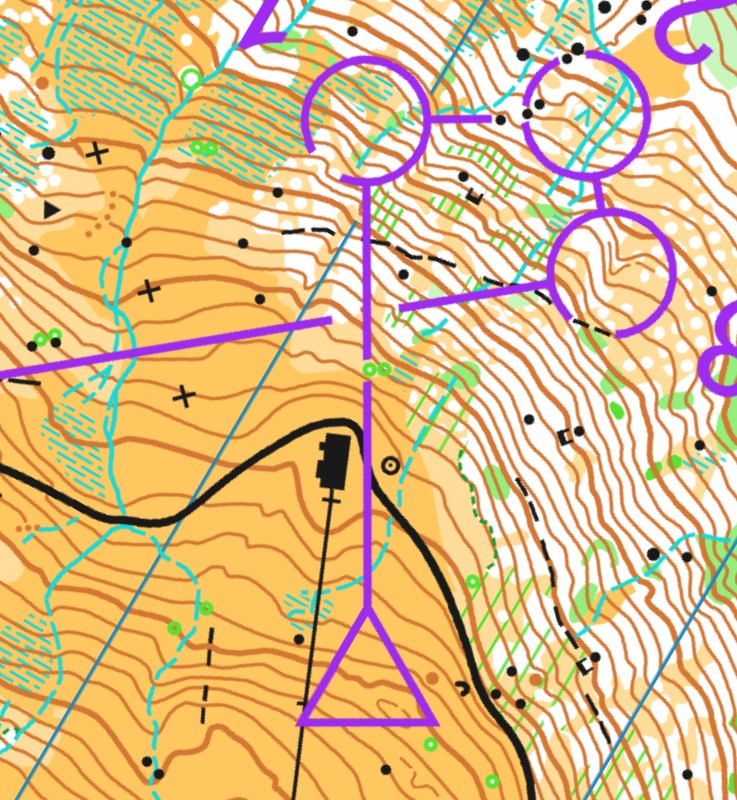
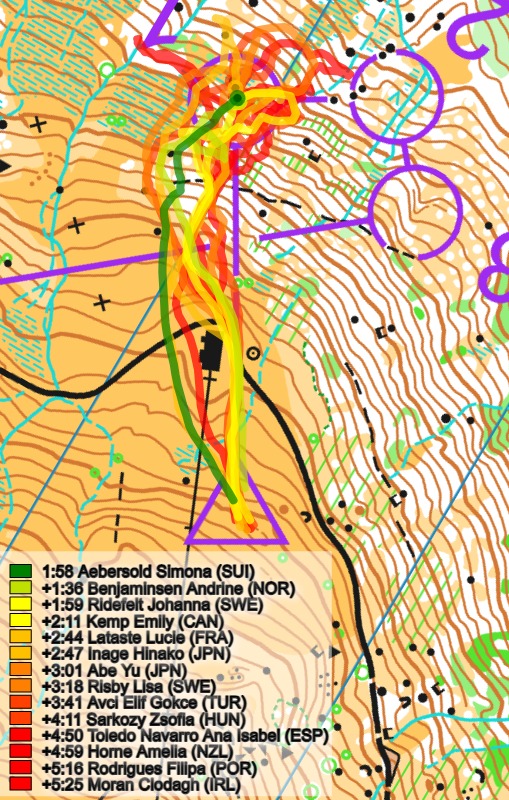
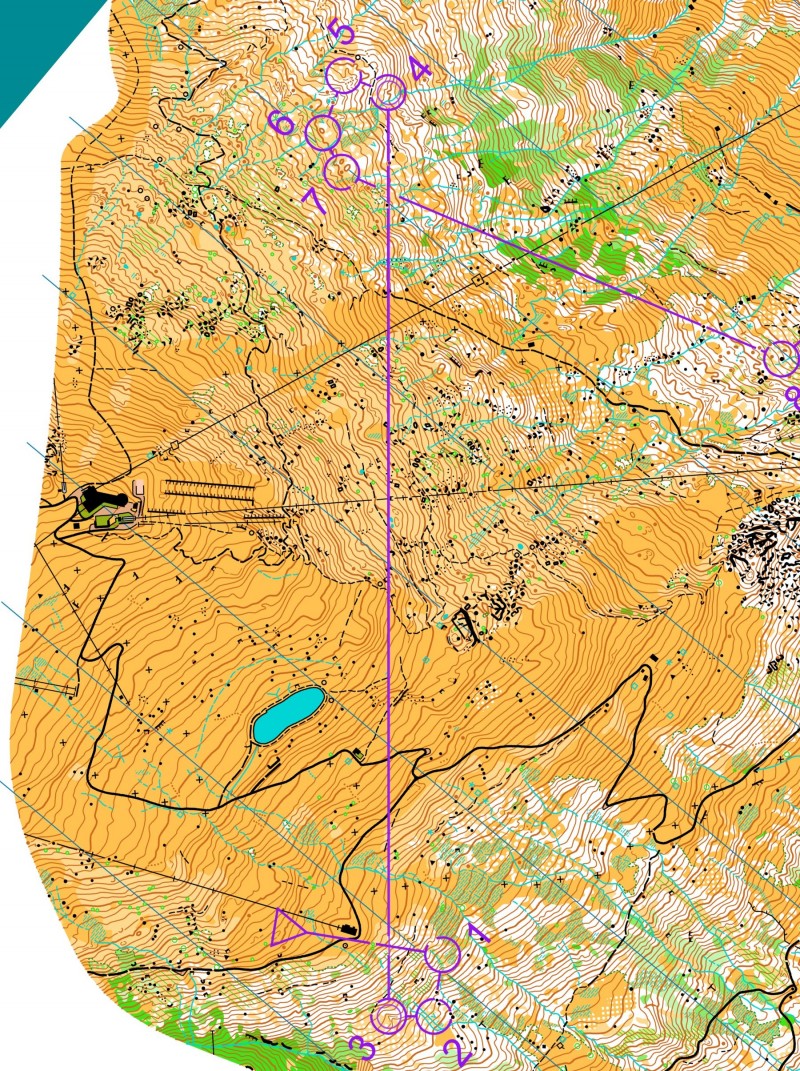


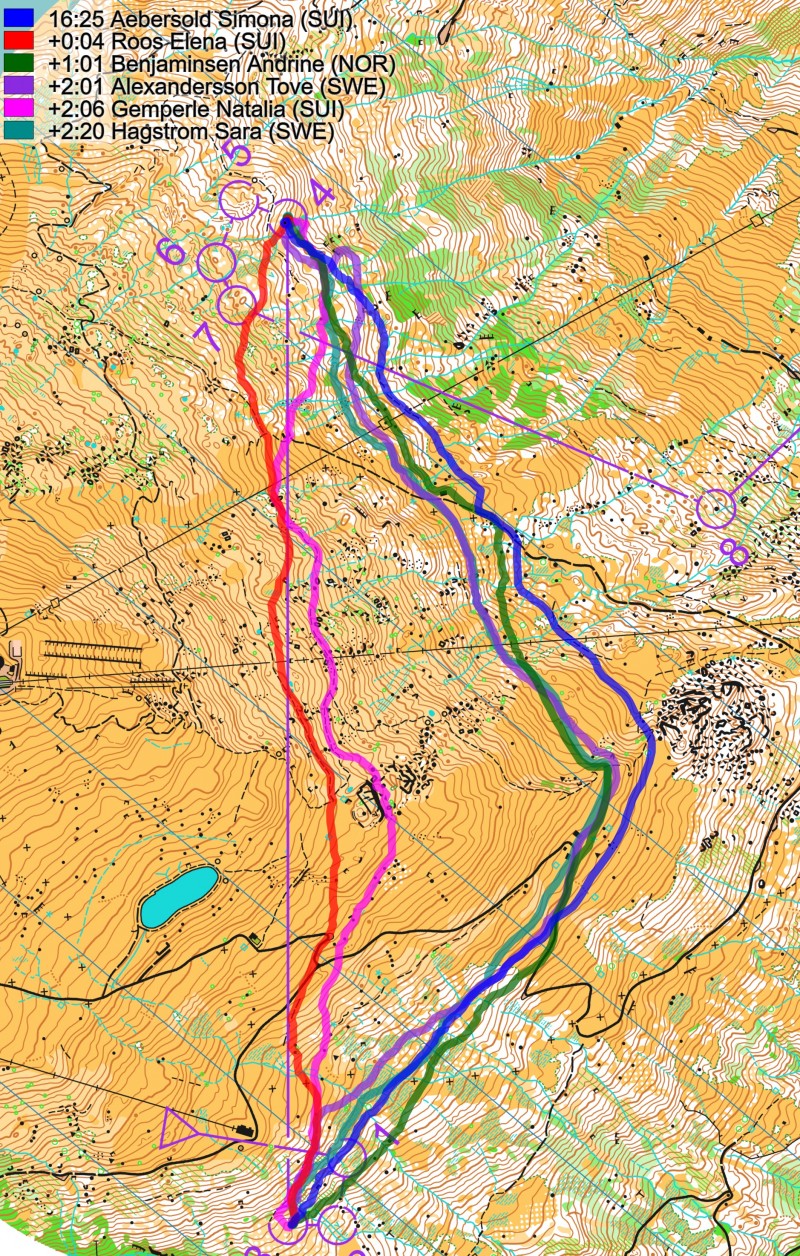
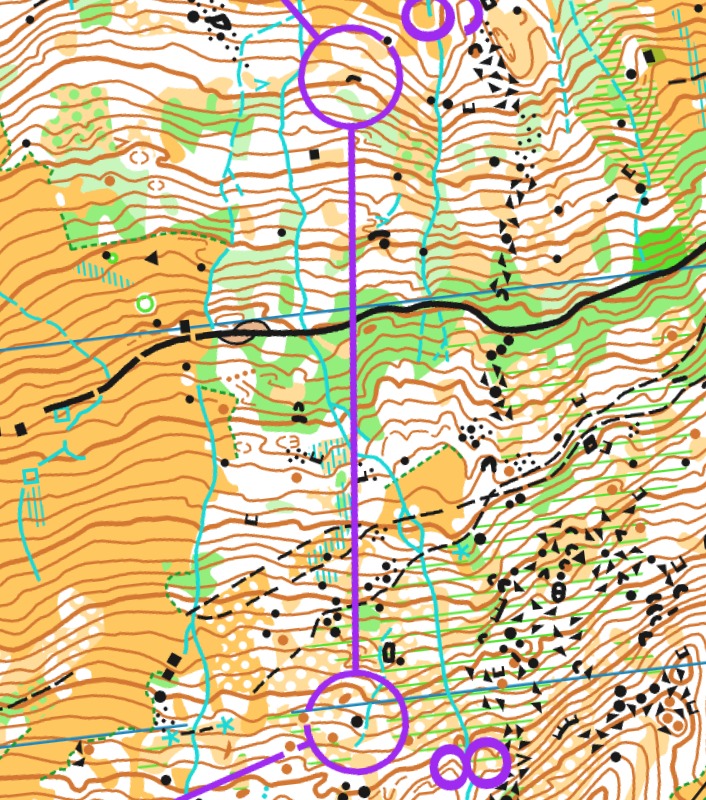
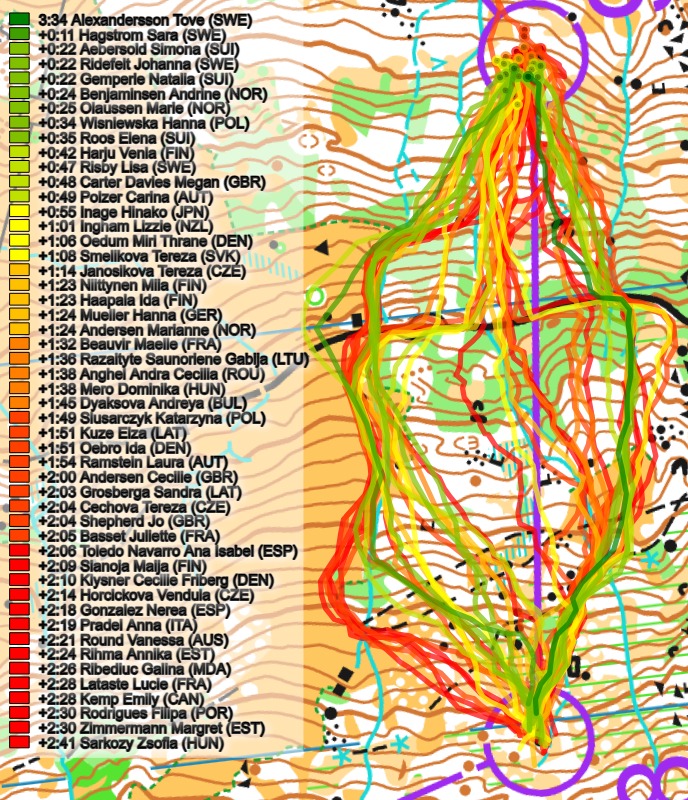
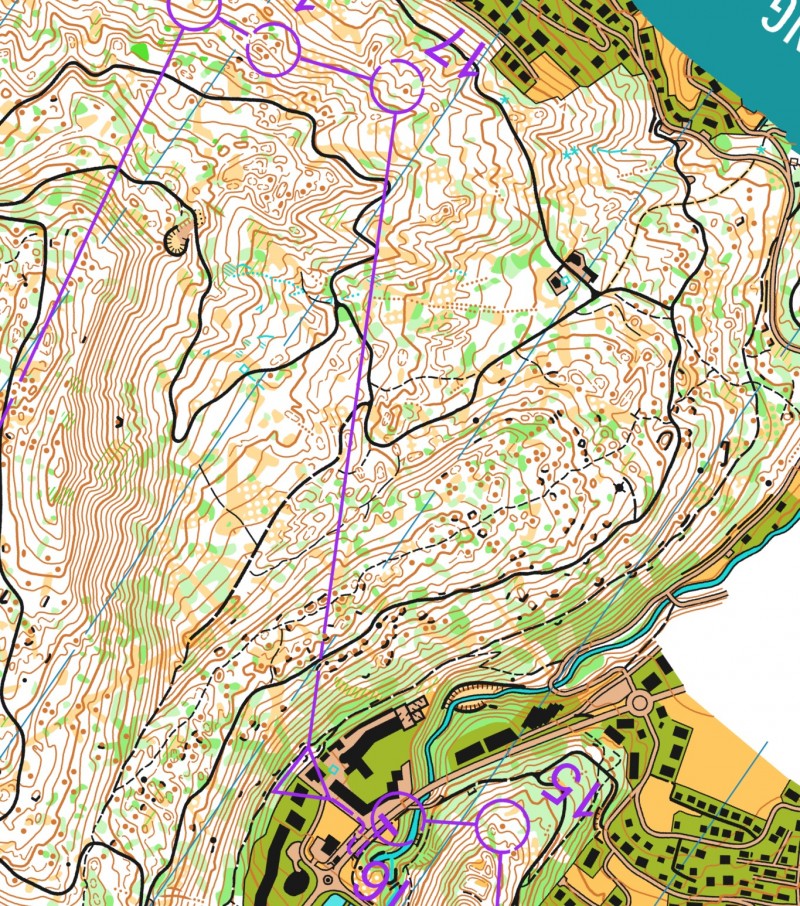
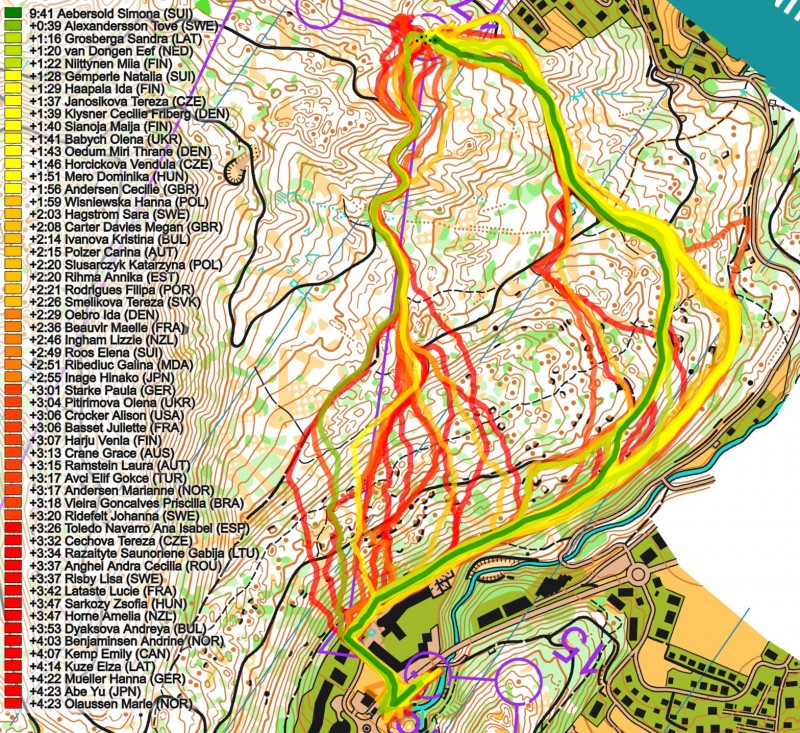
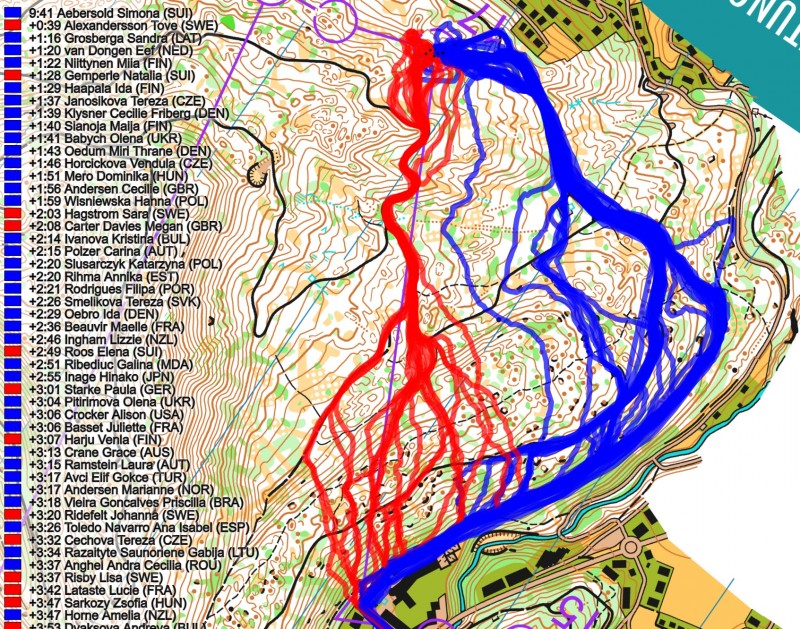
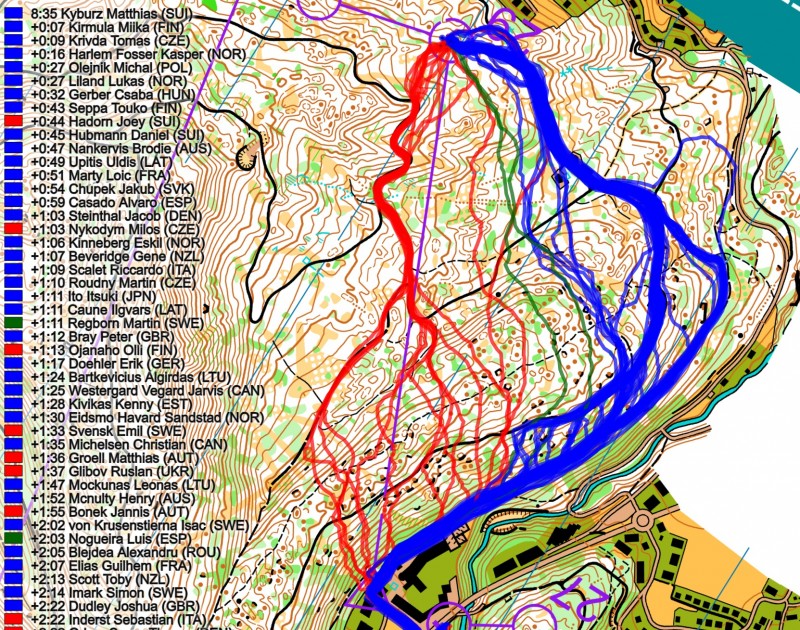
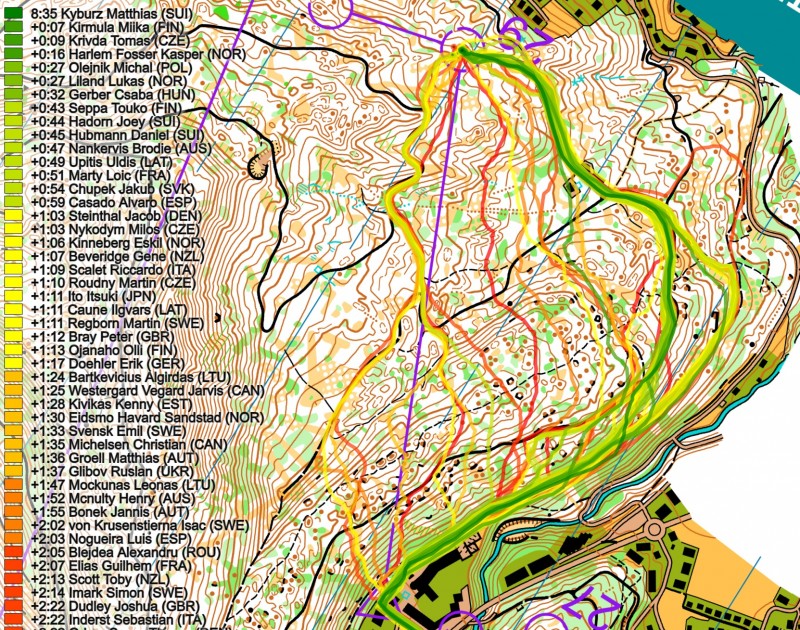
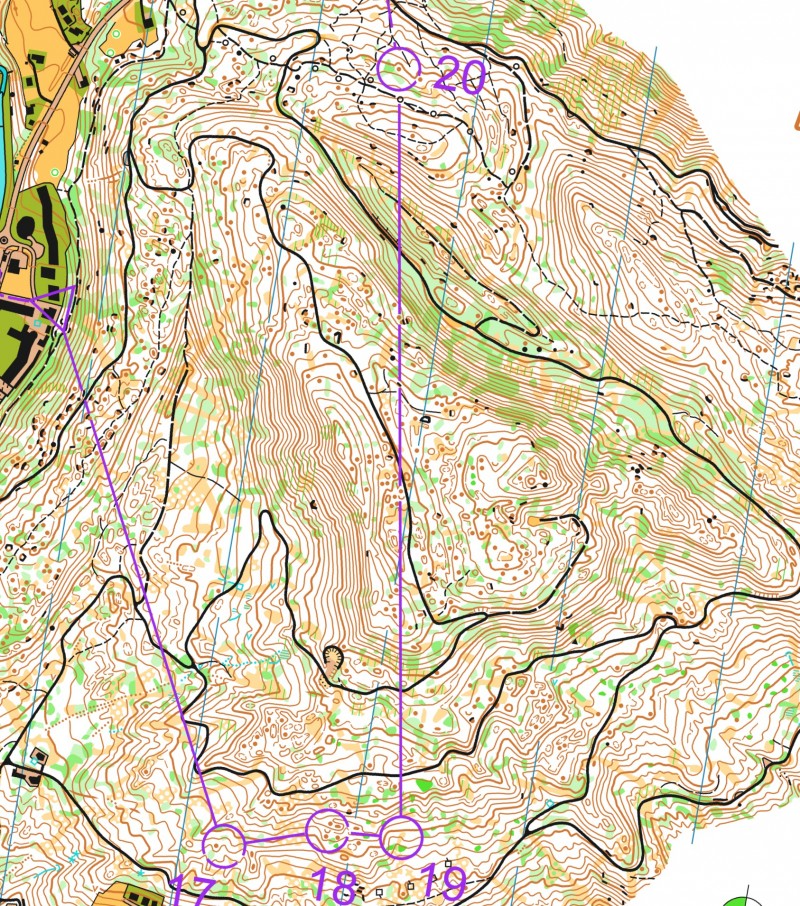
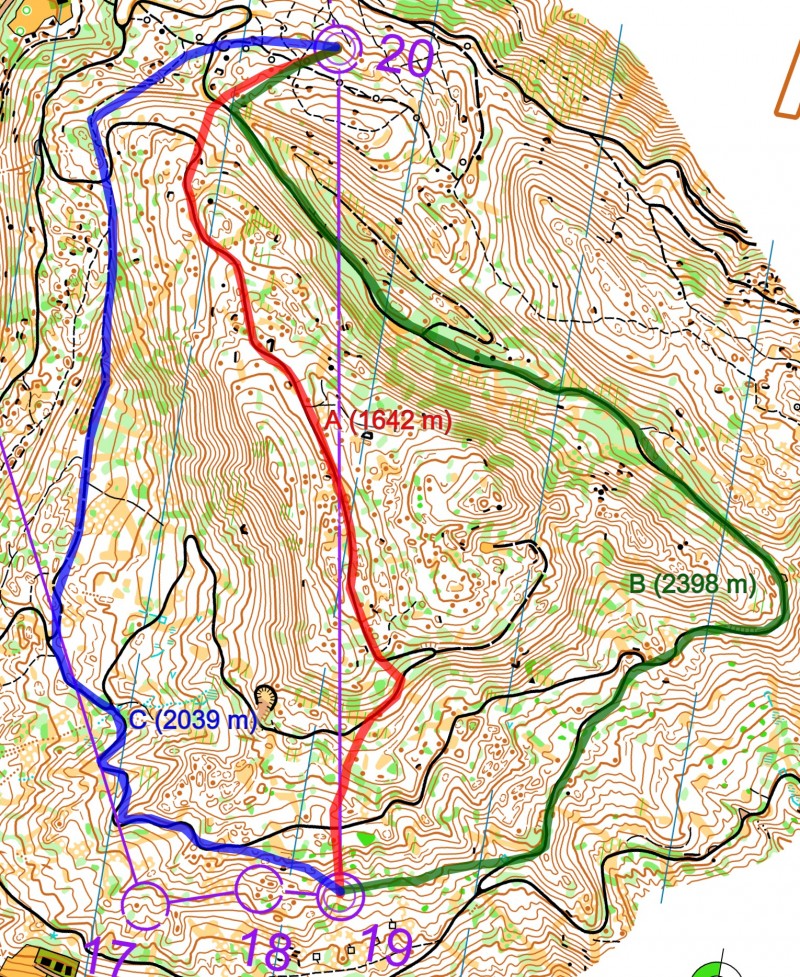
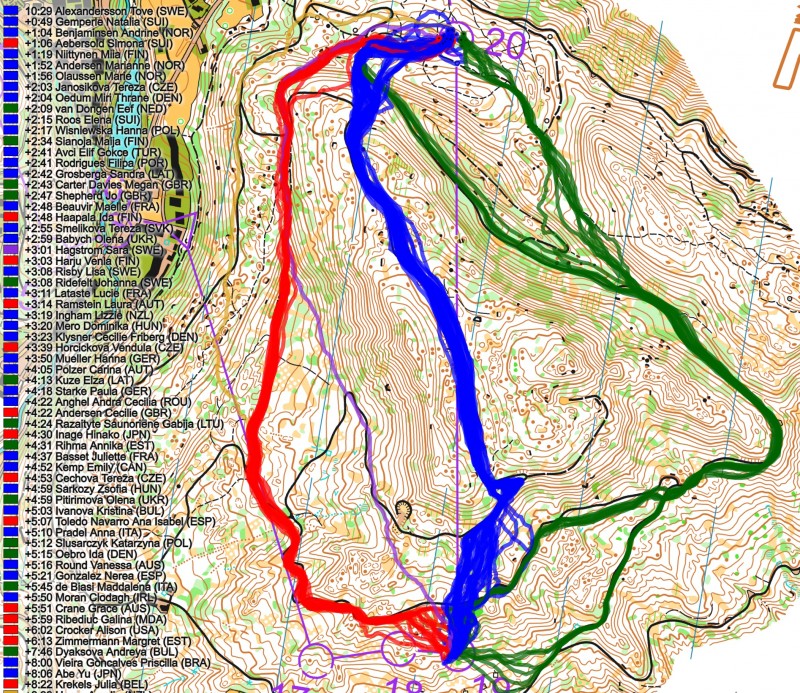
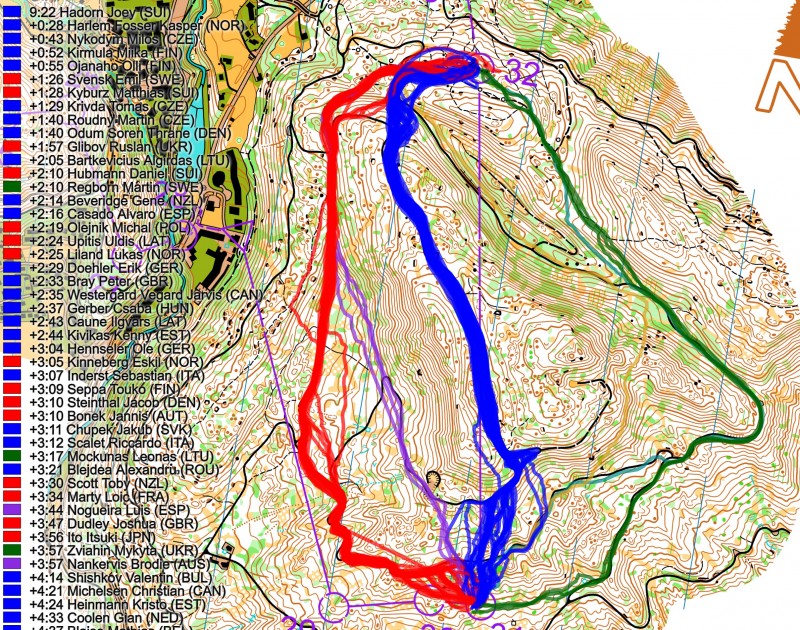
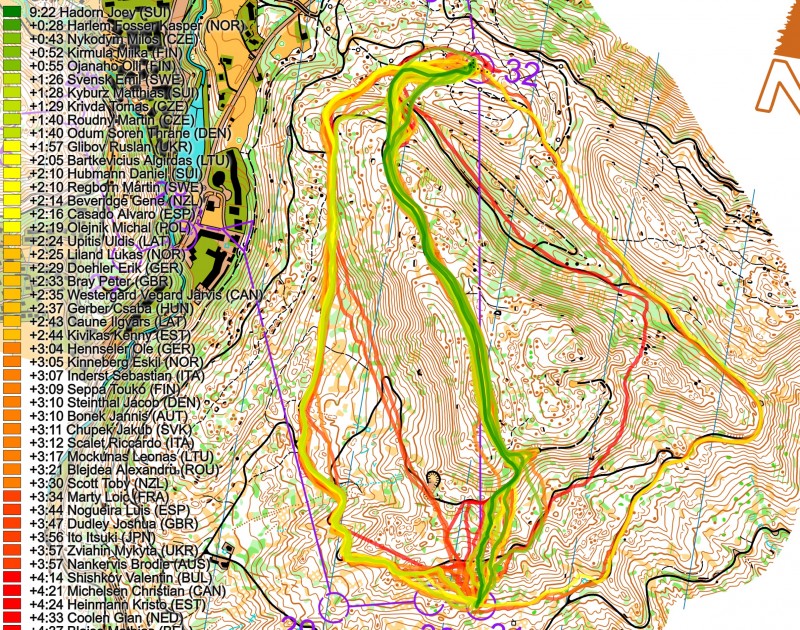
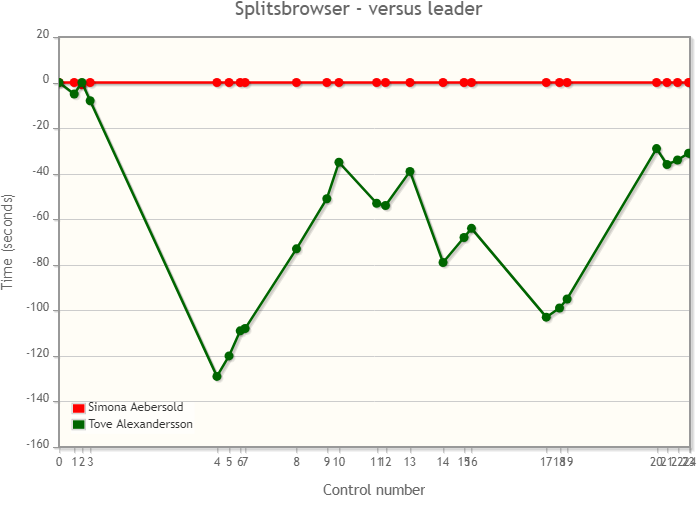
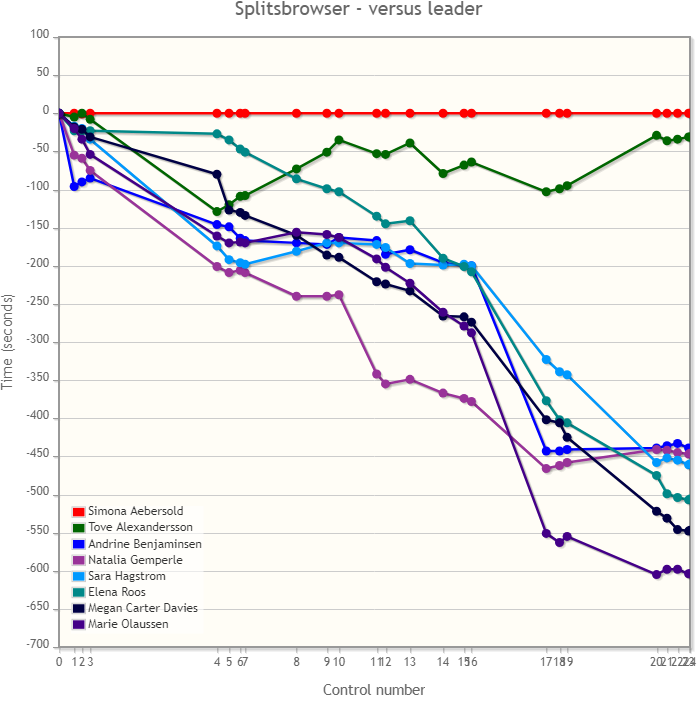
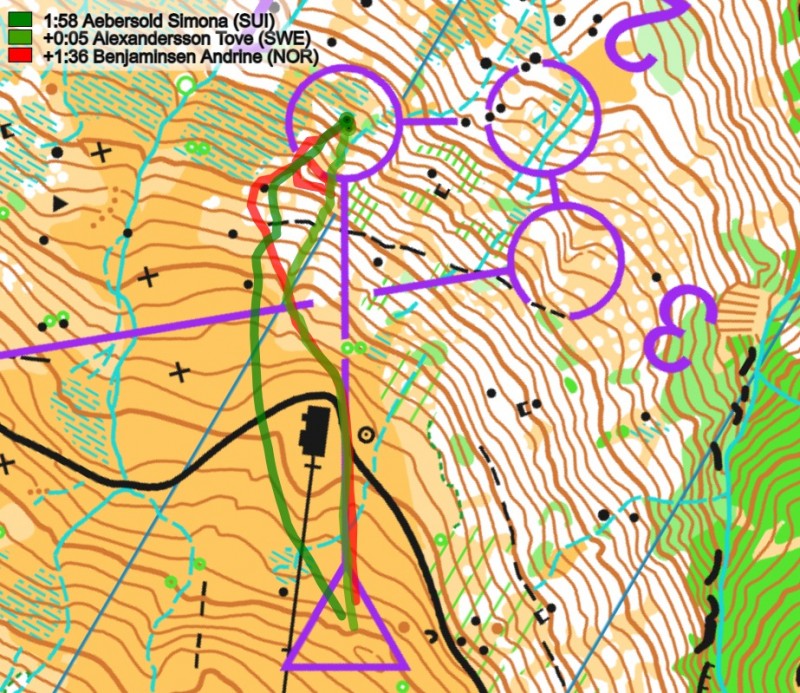
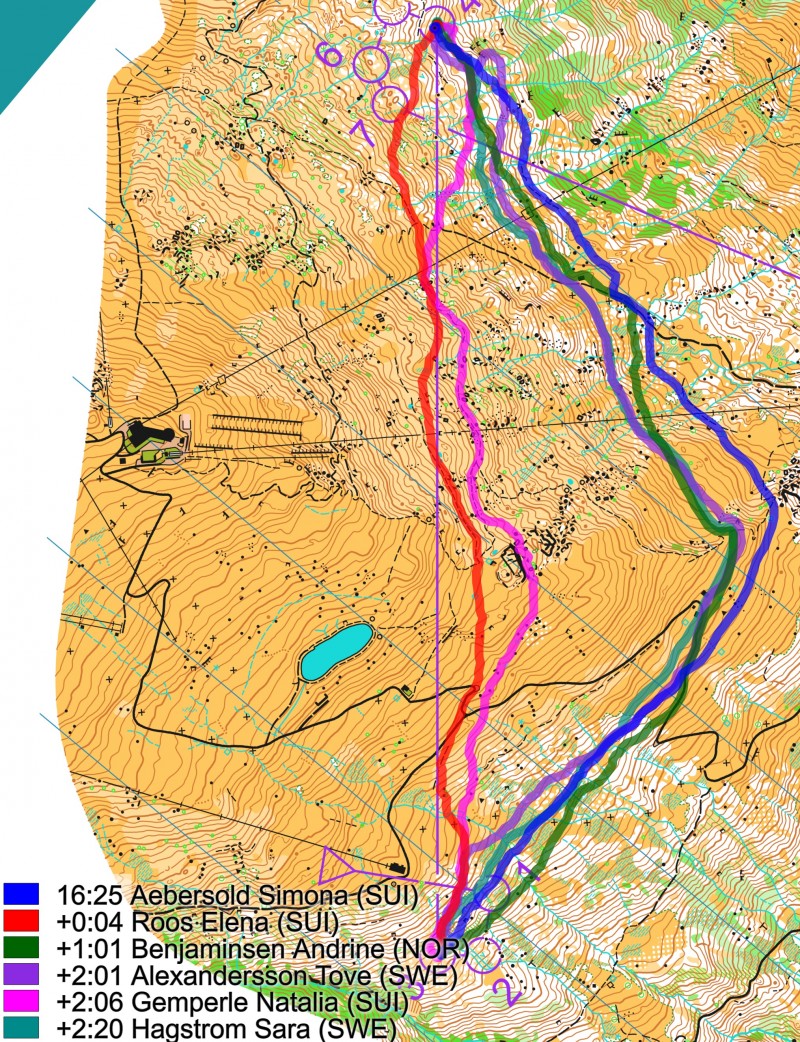
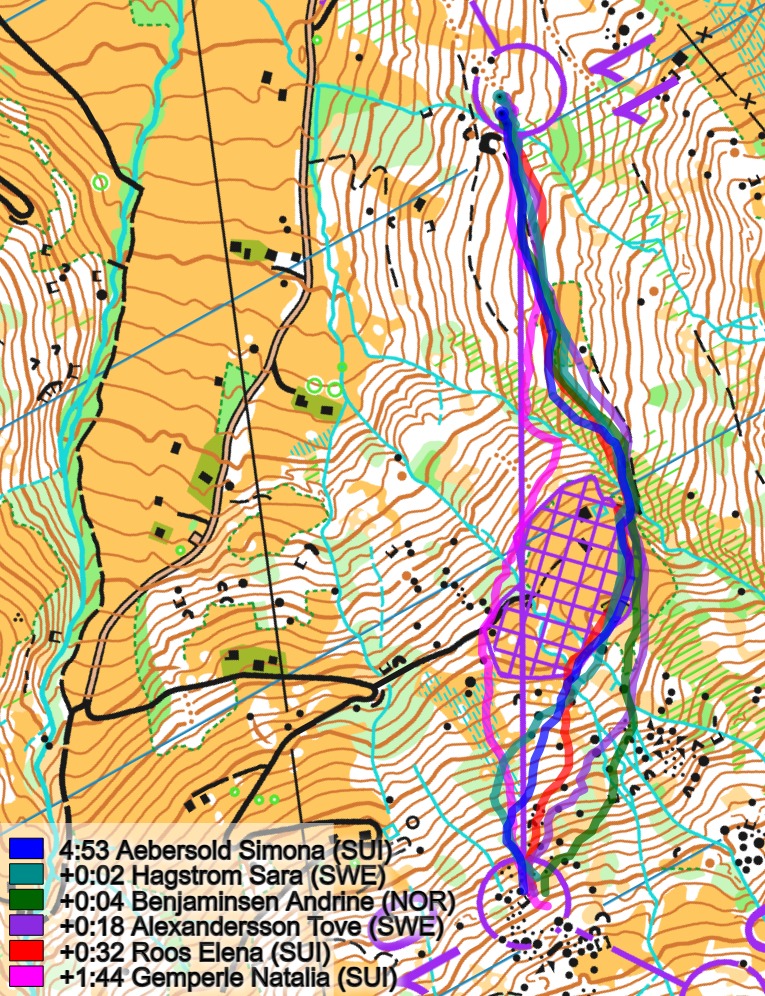
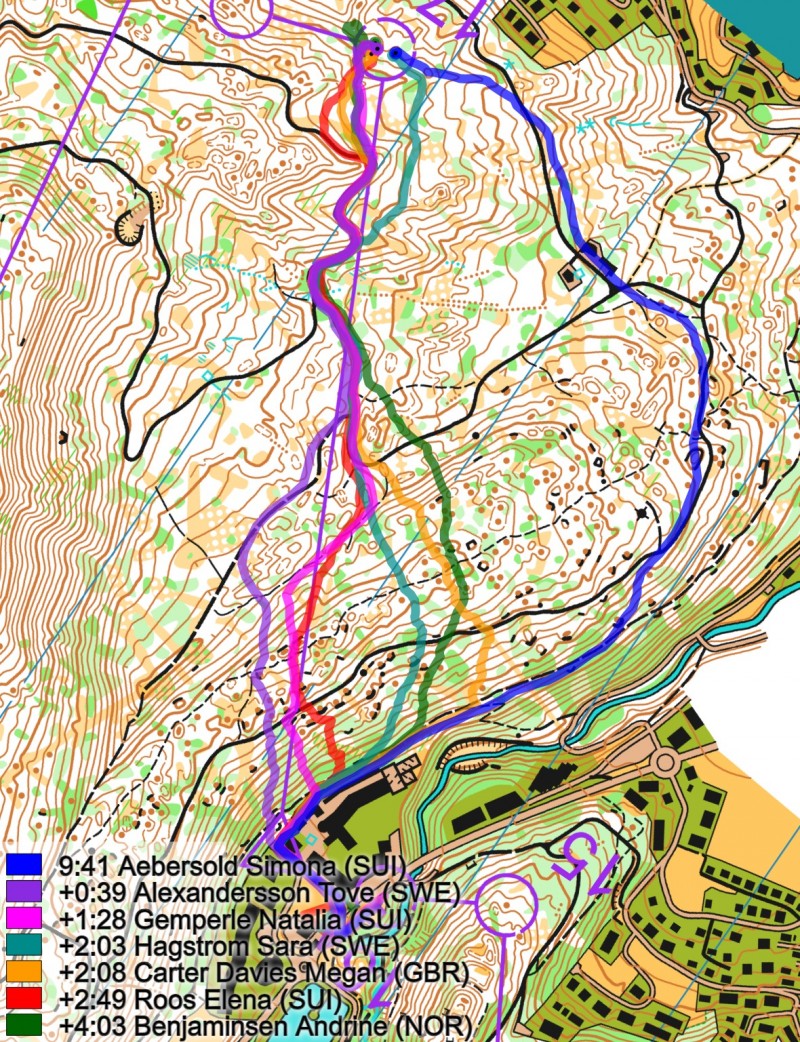
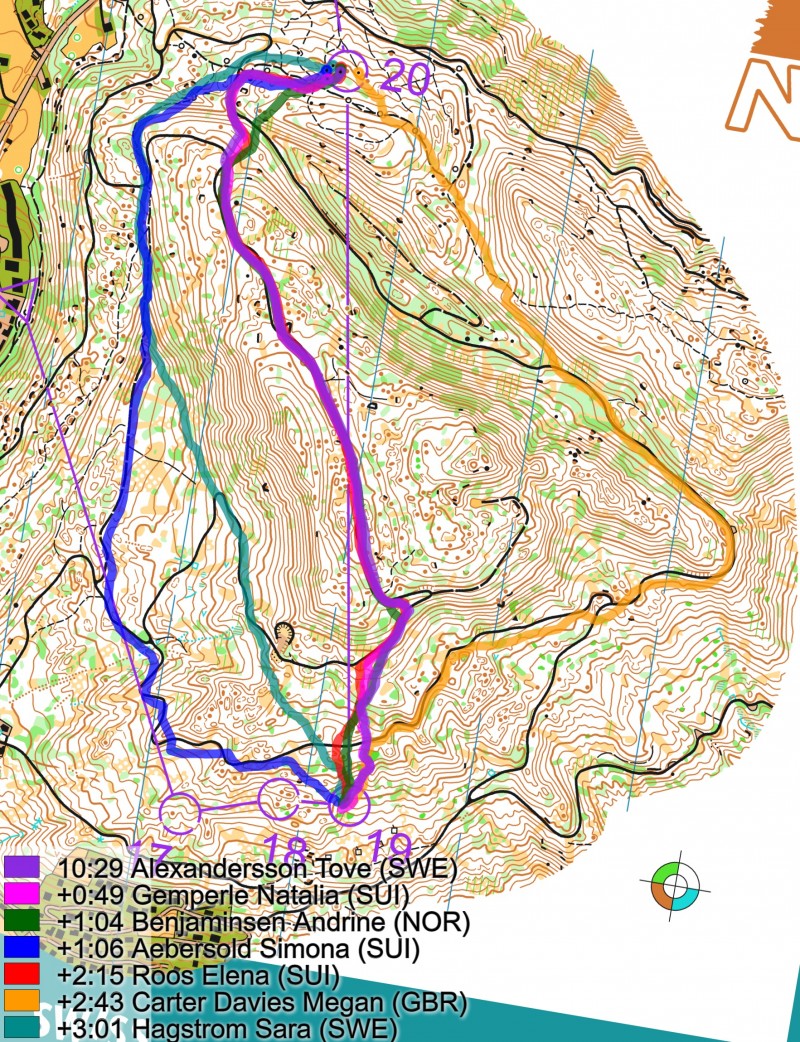
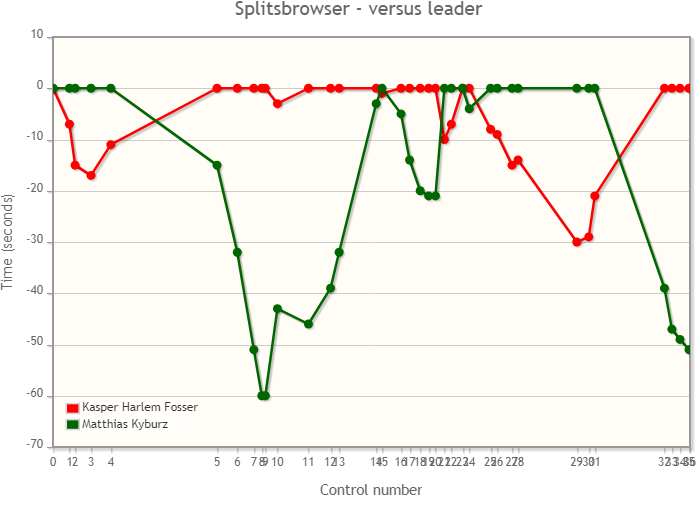
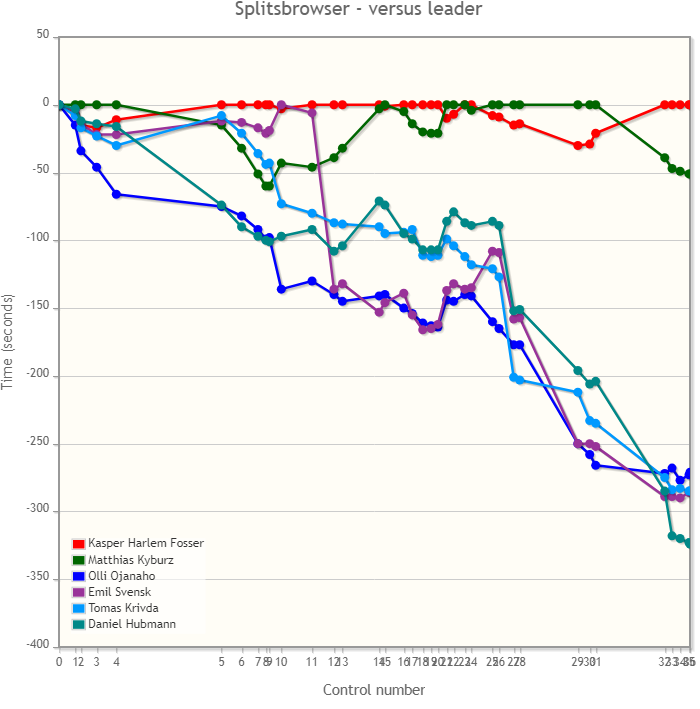
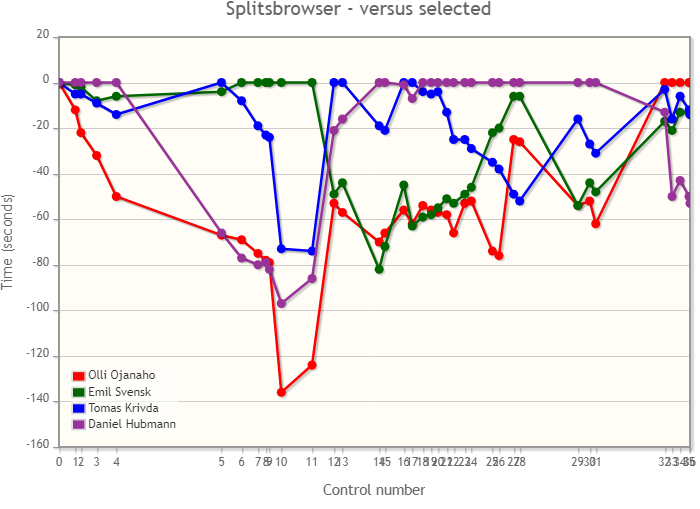
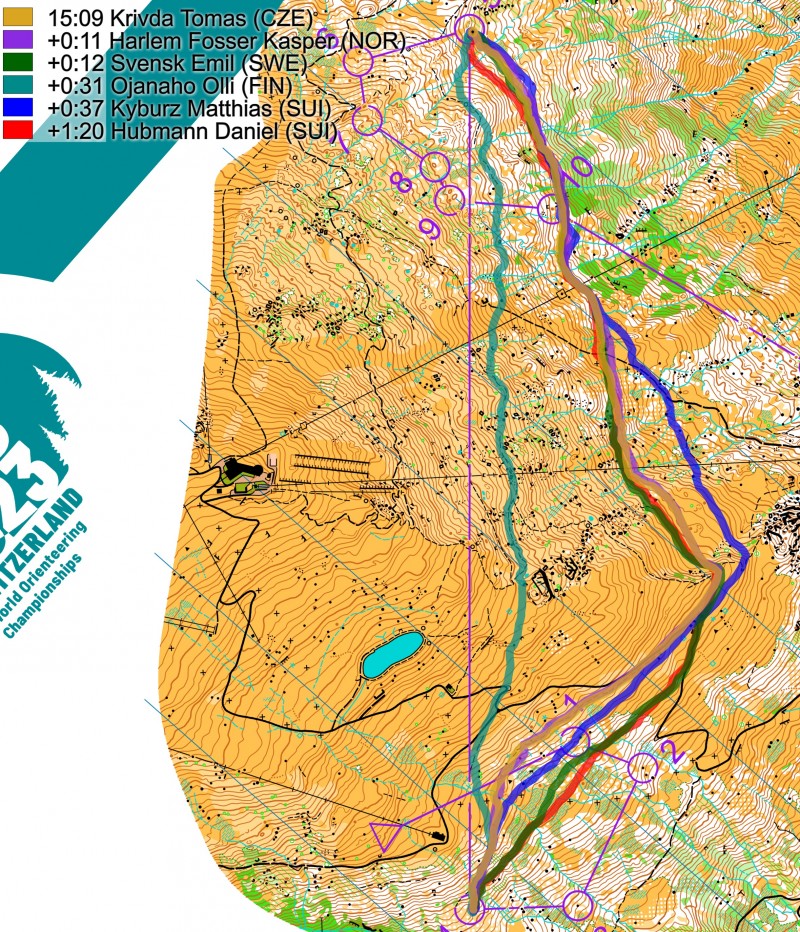
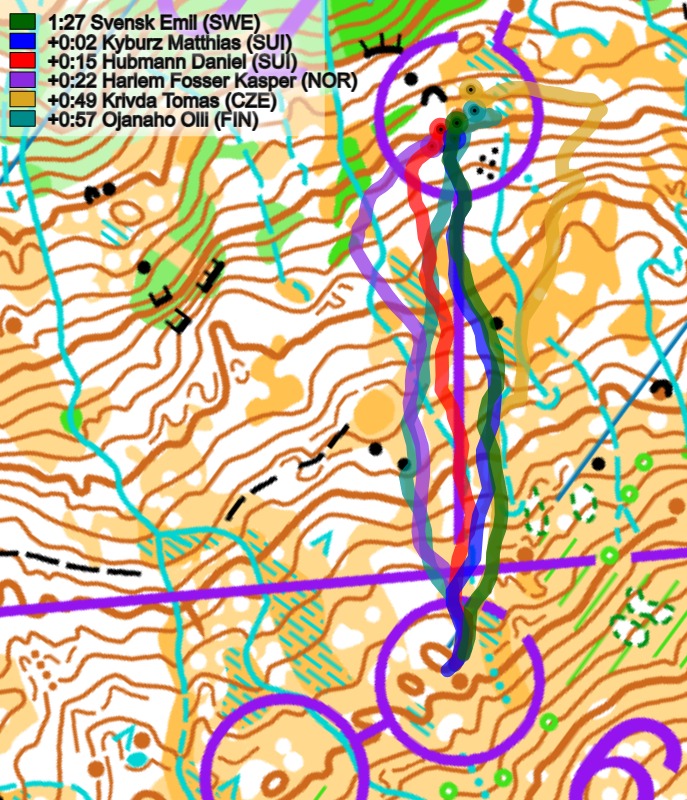
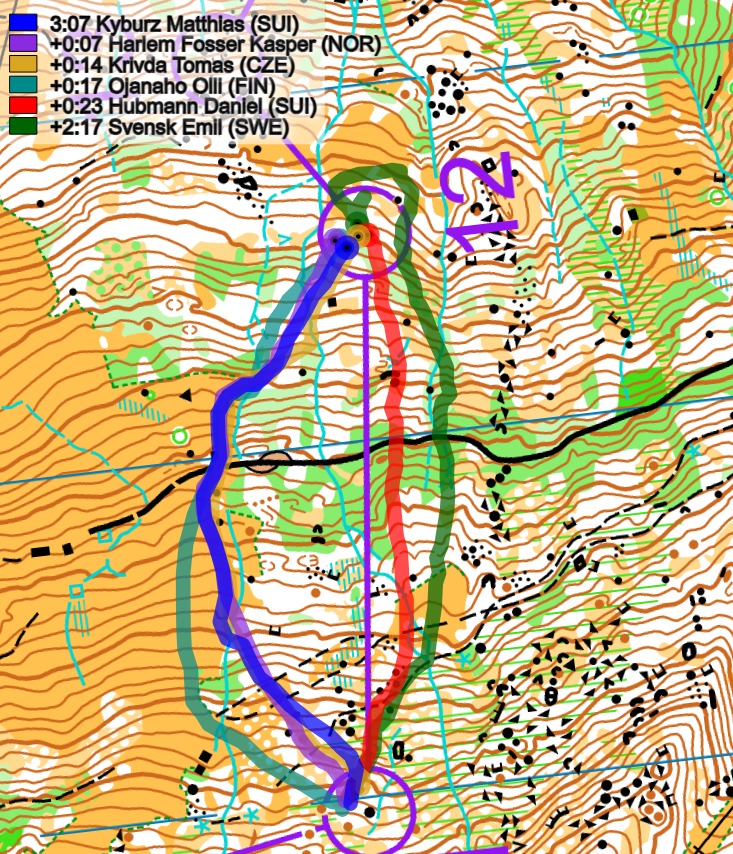
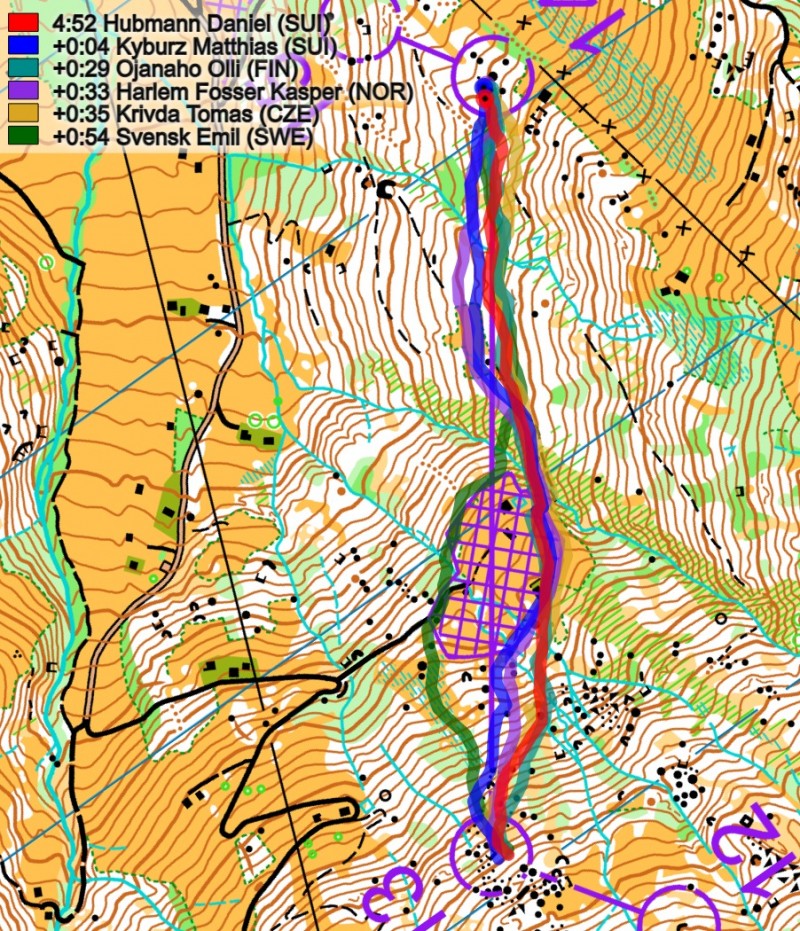
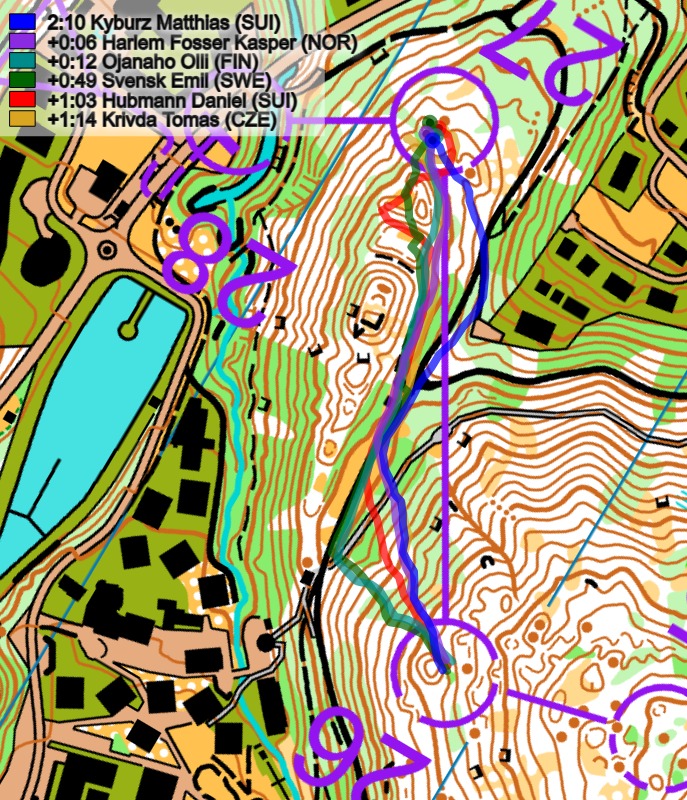
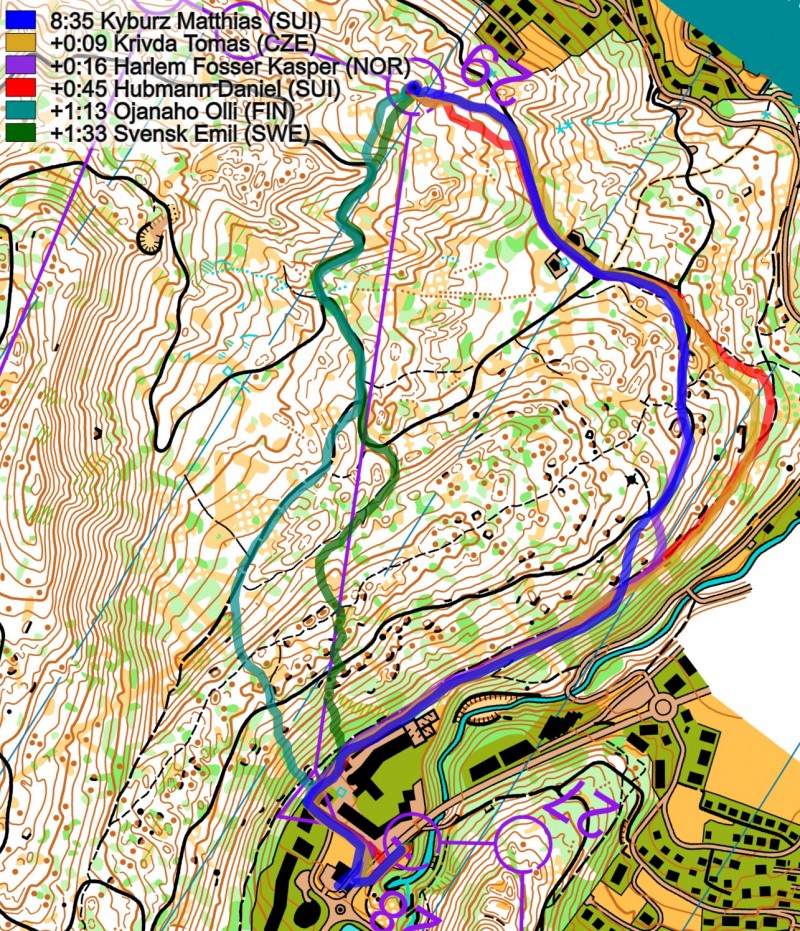
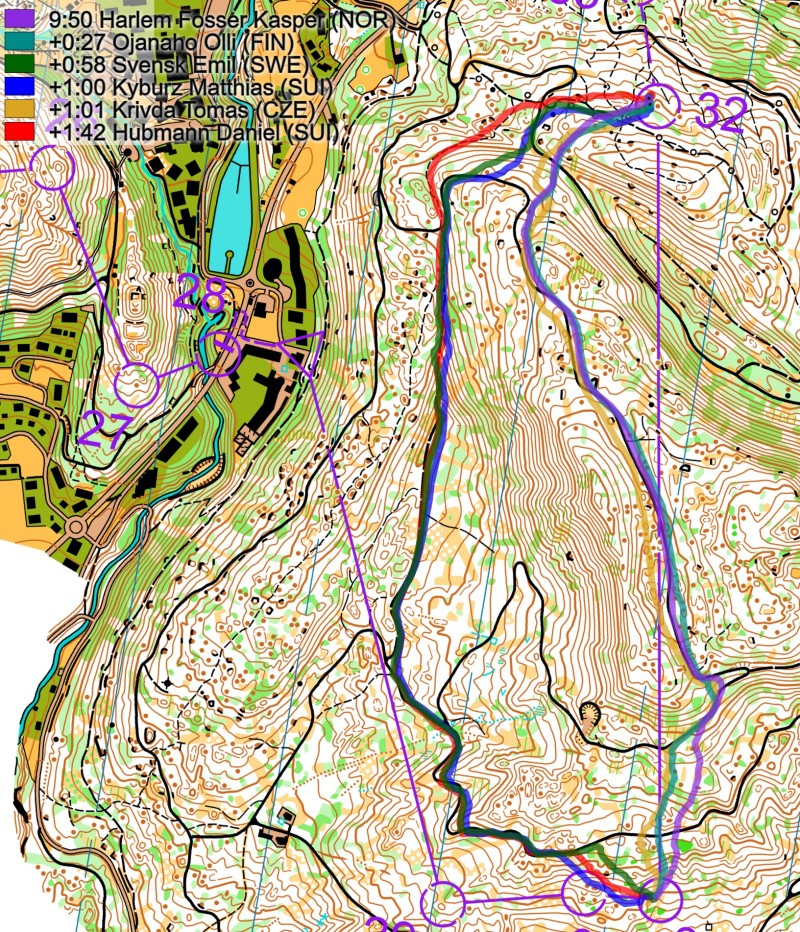
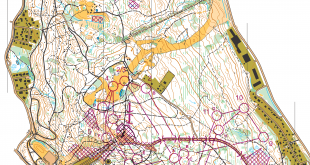
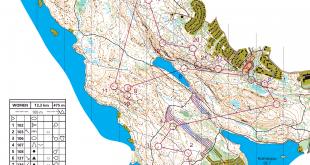
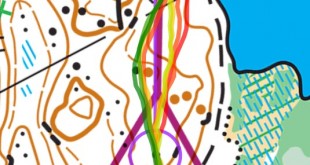
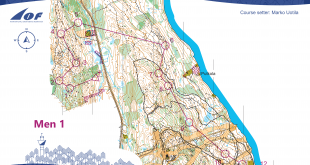
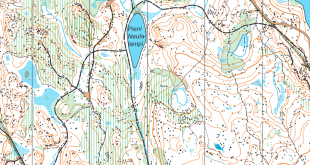
Thank for the analysis, very interesting. Two immediate small typos. 1) Women second part example leg steep downhill, here you say that the safest route is right via the open field instead of left. 2) Men analysis, here you say that Fosser lost a minute from control 4-7 compared to Kyburtz, rather it was the opposite.
Thanks, should be fixed now!
Wow, Jan! A master piece of orienteering analysis for a master piece of orienteering course.
At the same time, I notice that this isn’t for big audiences. We have to assume it.
Many thanks for your work.
Jan, as always thank you for your analysis!
Regrading the last route-choice: Kyburz said in the interview he was beginning to feel cramps and therefore was not ready to run straigth and chose the path around. Also Hubmann mentioned that he was at his limit. Maybe the deciding factor in the end for Fosser was his physical superiority in the very end of a hard race.
@Lukas: I also heard that Matthias said so. I still think he would have won if he would have chosen to run straight. He increased his lead gradually to Kasper on the last loop until they took different route choices, so it looked like he was stronger physically. Kasper lost 28 seconds to Joey Hadorn on this leg (they both took the same route), while Matthias run approximately the same time as Emil Svensk who took his route (and had a very strong finish). I will update the article with some more illustrations from this leg so this is clearer.
Jan, you are probably correct, but I still think that Kasper, like Tove, was able to execute that brutal route choice on the last long leg much better than almost all the other runners. Matthias was clearly a tiny bit faster than Kasper on the fast running legs (downhill or roads), but Kasper could still be faster at uphill terrain running.
Another detail re. the women and Tove’s first big mistake: On the GPS tracking you could see that she had almost caught up with Andrine just before she started her downhill mistake. Is it possible that she lost even more than 2 min here?
@Terje: It was in the uphill from the map exchange and up to the 31st control Matthias increased the gap, but of course it was not very steep uphill. And he might have fired a bit too early.
Regarding Tove, she lost 2:01 on the leg according to the official splits which is what is shown in the analysis above. She was faster on the first part of the leg (7 seconds until crossing the road), but she then took a poorer route choice (running up instead of continuing on the height she was running), and lost more than those seconds before she started doing her mistake. So I don’t think she lost more than the 2 minutes…
Congrats, Jan.
Your analysis are so precise and full of knowledge. I’m learning a lot reading this. And more happy because our brazilian orienteer Priscilla was shown here. Many thanks.